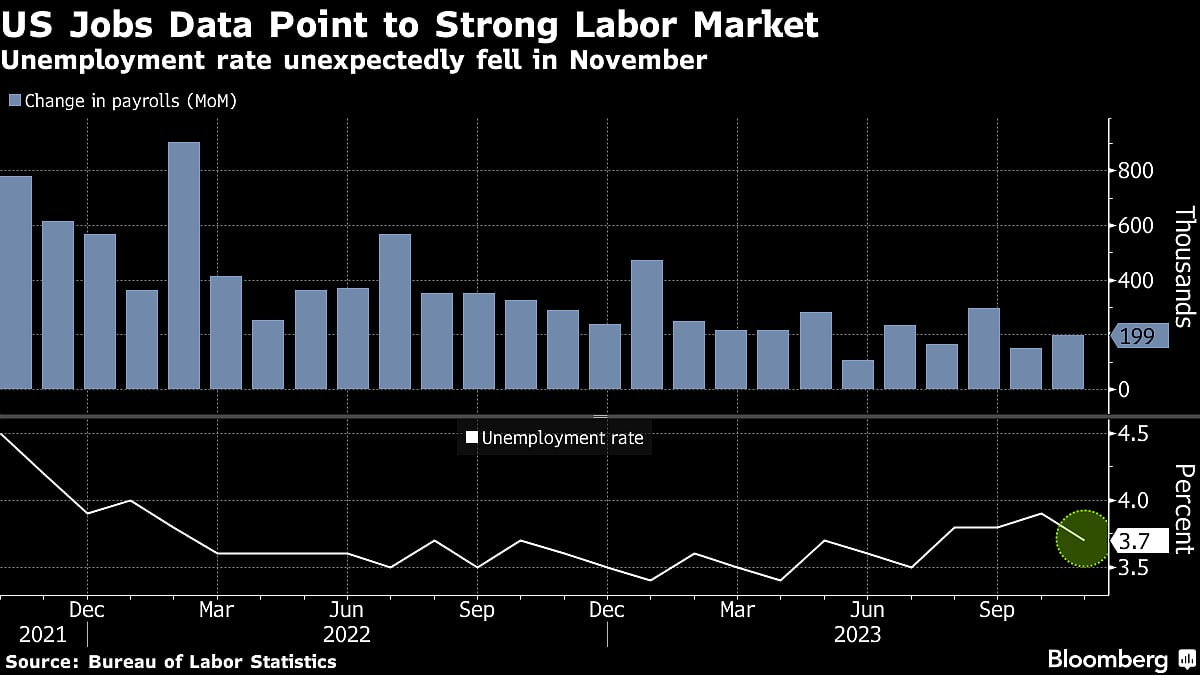US Labor Market Defies Slowdown Forecasts In Broad Strengthening
The US labor market unexpectedly strengthened in November with pickups in employment and wages, deflating hopes for the Federal Reserve to cut interest rates early next year.

(Bloomberg) -- The US labor market unexpectedly strengthened in November with pickups in employment and wages, deflating bets the Federal Reserve will cut interest rates early next year.
Nonfarm payrolls increased 199,000 last month following a 150,000 advance in October, a Bureau of Labor Statistics report showed Friday. The return of striking auto workers helped boost the count by 30,000. The unemployment rate fell to 3.7% and workforce participation edged up. Monthly wage growth rose more than forecast.

Health care, leisure and hospitality, and government hiring, in addition to the pickup in manufacturing upon the resolution of the United Auto Workers strike, drove the payrolls gain. Other categories showed tepid growth or outright declines, such as retail.
The acceleration in payrolls is at odds with recent reports that have depicted a softer hiring pace, an outcome favored by the Fed as it will help rein in demand and tame price pressures.
Follow the reaction in real time here on Bloomberg’s TOPLive blog
Fed officials are widely expected to keep borrowing costs at the highest level in two decades when they meet next week. Chair Jerome Powell has repeatedly pushed back against growing bets of rate cuts early next year, stressing that policymakers will move cautiously but retain the option to hike again. Treasury yields rose sharply after the figures.
“All in all, expectations of many cuts next year that begin in the first quarter will be pared back,” said Derek Tang, an economist with LH Meyer/Monetary Policy Analytics. “Fed policymakers will seize on this to call for patience and a longer hold.”
The solid labor-market figures shift focus to inflation numbers as Fed officials gauge how long to maintain interest rates at this cycle’s peak. A further cooling of price gains would likely help push the central bank toward rate cuts as long as the job market averts a more sustained re-acceleration.
“The totality of the data will allow the Fed to remain patient to make sure inflation is moving back to target,” said Yelena Shulyatyeva, senior US economist at BNP Paribas.
What Bloomberg Economics Says...
“Most of the gains in headline nonfarm payrolls came from government, health care, and the resolution of strikes. But those don’t reflect underlying conditions in the labor market, and the Fed will likely look through their strength. Our view remains that the Fed is likely to begin cutting rates in March 2024.”
— Anna Wong, Stuart Paul, Eliza Winger and Estelle Ou
For the full note, click here.
Average hourly earnings rose 0.4%, matching the biggest monthly advance this year, and were up 4% from November 2022. Earnings for nonsupervisory employees, who make up the majority of workers, also increased 0.4%.
The participation rate — the share of the population that is working or looking for work — rose to 62.8%, driven by men. For those ages 25-54, participation was unchanged. A further increase in the labor supply could help alleviate wage gains.
The jobs report is composed of two surveys: one of households and one of businesses. The household survey showed a 747,000 surge in employment, far offsetting a decrease in the prior month. A large number of people previously not in the labor force, as well as those previously unemployed, were able to find jobs.
The gain in payrolls, combined with stronger wage growth and a pickup in hours worked, led a broad measure of labor market health to jump 0.7% last month, the most since June. Moreover, a gauge of take-home pay rose 0.3%.
--With assistance from Reade Pickert, Augusta Saraiva, Kristy Scheuble and Steve Matthews.
(Adds Bloomberg Economics comment)
More stories like this are available on bloomberg.com
©2023 Bloomberg L.P.